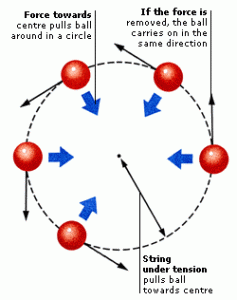Cycling Circular Motion
When we are talking about turning and cornering, the cyclist’s motion can be approximated as moving along a circle. This certainly does not describe a hairpin turn, but the basic principles remain the same. All that changes are the magnitudes of the quantities as each segment of a non circular turn can be approximated as circular. All of this means that in order to understand cycling circular motion, we need to first understand the fundamentals of circular motion.
Characterizing Circular Motion
From Newton’s Laws, we know the inertial tendency of an object is to continue forward in a straightline at its current speed unless acted upon by external forces. Based on that definition, circular motion is a deviation from the inertial tendency of the object and something the object will resist. In fact, it is this need to counter an object’s inertial tendency that creates the need for some type of forces to be acting on the object while it is following a curve path.
Forcing an object to move along a curve path
How must you force an object to move along a curve path? A simple example is that of a weight attached to a string. As you swing it around your head, it moves in a circle with constant velocity and angular rate.

You will feel in your hand that the weight is exerting a constant pull on your hand via the string. Unlike straight line motion, the weight will stop curving if the force disappears.
What you see is that circular motion is defined by a constant force directed towards the center of the circular motion. If you take a Physics 101, the magnitude is computed using geometric arguments as the following:
F = mv2/R
Here m is the mass, not weight, of the object, and v is its current speed along the curve while R is the radius of the curve it is moving along. Another way of thinking of v is it is the speed the object would move away in a straightline if you let go of the string. Think of this as an Argentinian Bola.
Circular Motion and Forces
The following diagram provides an excellent of the forces at play in circular motion.

Next Topic: Centripetal and Centrifugal Forces
